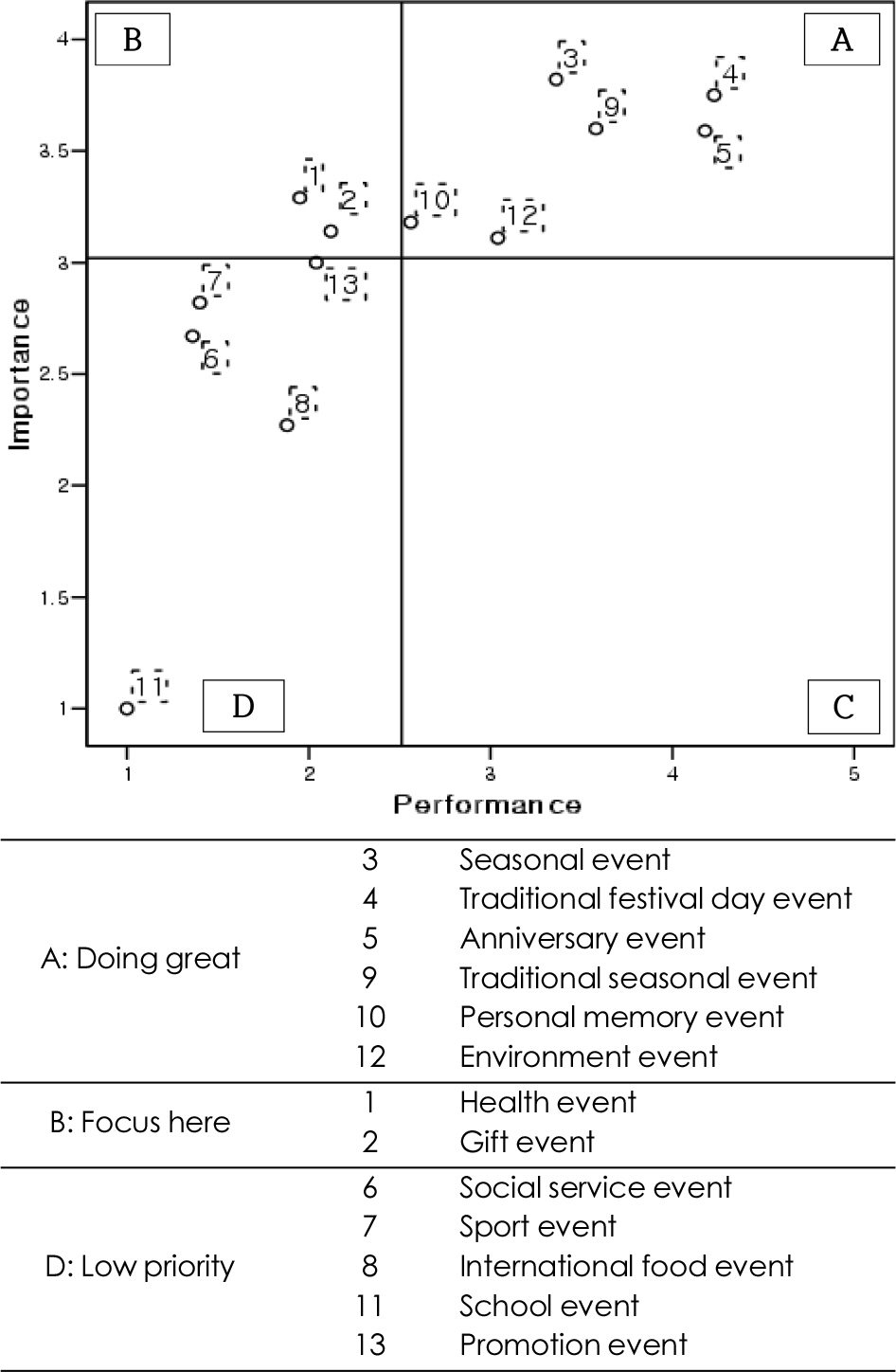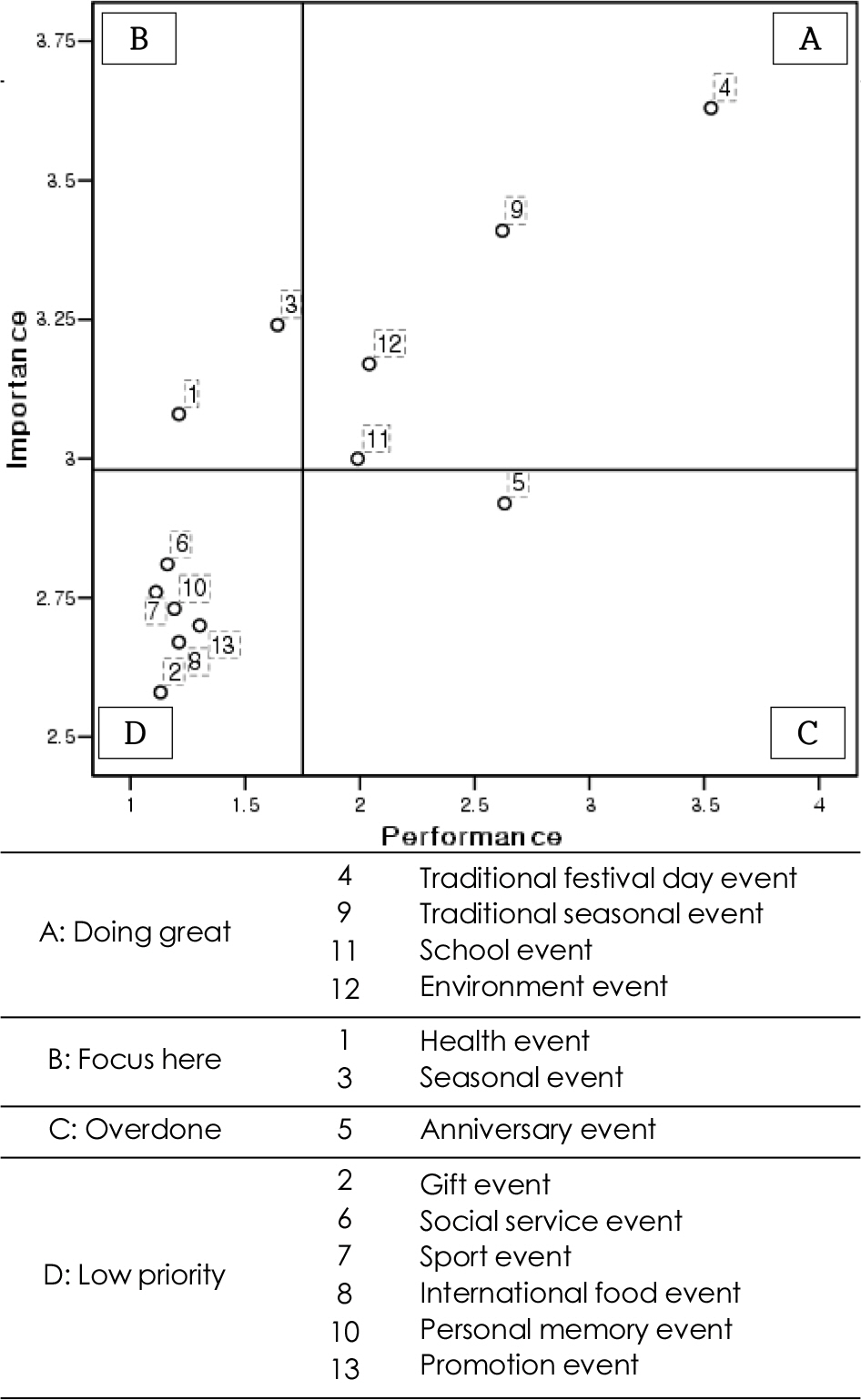J Nutr Health.
2014 Dec;47(6):452-462. 10.4163/jnh.2014.47.6.452.
Comparative analysis on status of events and importance-performance analysis (IPA) between industry and school foodservices
- Affiliations
-
- 1Major of Nutrition Education, The Graduate School of Education, Chonbuk National University, Jenju, Jeonbuk 561-756, Korea.
- 2Department of Food Science and Human Nutrition, Chonbuk National University, Jenju, Jeonbuk 561-756, Korea. jorho@jbnu.ac.kr
- KMID: 2327100
- DOI: http://doi.org/10.4163/jnh.2014.47.6.452
Abstract
- PURPOSE
The purpose of the study was to evaluate the status of events and importance-performance analysis (IPA) between industry and school foodservices.
METHODS
The study subjects were dietitians in industry foodservices (n = 73) and nutrition teachers in school foodservices (n = 135) in the Jeonbuk area. Demographic characteristics, status of events, and problems of implementing events were assessed using a self-administered questionnaire.
RESULTS
Approximately 67% of industry foodservices had implemented an event a month, whereas 40.7% of school foodservices did not implement events for students. The type of events that industry and school foodservices had implemented most frequently were Sambok event, Dongji event, Daeboreum event, Spring-Namul event, and Chuseok event. The industry foodservices had significantly higher average scores for performance of events than those of the school foodservices (p < 0.001). In the Importance-Performance Analysis (IPA), high importance and high performance (A area: doing great) in industry foodservices were seasonal events, traditional festival day events, anniversary events, traditional seasonal events, and personal memory events, whereas in school foodservices were traditional festival day events, traditional seasonal events, school events, and environment events.
CONCLUSION
These results showed that events are important for the increase in customer satisfaction. Therefore, it is necessary to consider educational programs on event implementation for dietitians and employees in industry and school foodservices.
Keyword
MeSH Terms
Figure
Reference
-
References
1. Meffert H. Marketing. 9th edition.Wiesbaden: Gabler Verlag;2000.2. Yang IS, Yi BS, Kim HA, Kang JK. Analyzing the status and attributes affecting customers' participation on the events marketing in the contract-managed foodservice. J Foodserv Manage. 2005; 8(1):105–126.3. Lee JE. The influence of foodservice corporation event on corporation image and intention of relation. Event Conv Res. 2011; 7(1):77–95.4. Kim YG, Suh BW, Eves A. The relationships between food-related personality traits, satisfaction, and loyalty among visitors attending food events and festivals. Int J Hosp Manag. 2010; 29(2):216–226.
Article5. Kim G. Event participant's expectations and satisfaction analysis intention: Seoul super deluxe hotel centered. Korea J Tourism Hosp Res. 2013; 27(1):421–430.6. Park JH, Jin YH. Research about choice attribution customers make in food & beverage events. Korean J Culinary Res. 2004; 10(1):32–45.7. Foodbank (KR). Hyundai green food, customer satisfaction is our priority [Internet]. Seoul: Foodbank;2008. [cited 2013 May 1]. Available from:. http://www.foodbank.co.kr.8. Foodbank (KR). Hyundai green food, detox-menus against yellow sand from China [Internet]. Seoul: Foodbank;2009. [cited 2013 May 1]. Available from:. http://www.foodbank.co.kr.9. Foodbank (KR). OurHome, enhancement of communication with customer [Internet]. Seoul: Foodbank;2010. [cited 2013 May 1]. Available from:. http://www.foodbank.co.kr.10. Foodbank (KR). Hyundai green food, sodium down, health up [Internet]. Seoul: Foodbank;2012. [cited 2013 May 1]. Available from:. http://www.foodbank.co.kr.11. Foodbank (KR). OurHome, daily meals using Korea pork meat [Internet]. Seoul: Foodbank;2013. [cited 2013 May 1]. Available from:. http://www.foodbank.co.kr.12. Bae HJ. A survey on preference of the event menus in the foodservice operations for university students. J Korean Diet Assoc. 2006; 12(3):235–242.13. Lee KA. A study on special events at school foodservice operations in the Busan area. J Korean Diet Assoc. 2008; 14(2):152–165.14. Jeong JH, Kim EJ, Kim MH, Choi MK. Perception of eco-friendly agricultural products and food service satisfaction of elementary and middle school students according to eco-friendly food service day in Chungnam. J Korean Soc Food Sci Nutr. 2013; 42(1):114–119.
Article15. Stiftung-bildung-und-gesellschaft.de (DE). Bildung beginnt im Magen – Primus-Preis für Hamburger Schul-Projekt [Internet]. Frankfurt: Ernahrungs Umschau;2014. [cited 2014 Feb 19]. Available from:. http://www.ernaehrungs-umschau.de.16. Deutsches Netzwerk Schulverpflegung e.V. Schulmilchprogramm der EU [Internet]. Berlin: Deutsches Netzwerk Schulverpflegung e.V;2014. [cited 2014 Oct 1]. Available from:. http://www.schulverpflegung.net.17. Lyu ES. Dietitians' perception and application of festival foods in the school foodservice in Busan area. Korean J Food Cult. 2003; 18(2):160–171.18. Lee KA. Evaluation of importance and performance by dietitians about events marketing at school foodservice operations in Busan. J Korean Soc Food Sci Nutr. 2009; 38(12):1794–1800.
Article19. Lülfs-Baden F, Spiller A. Why children fail to go to the canteen: acceptance of school food. Ernährungs Umschau. 2009; 56(9):506.20. Rho JO. Satisfaction with the school food services in Korea. Ernährungs Umschau. 2009; 56(11):612.21. Lee SY. A survey on customer's perception for event preference and importance in food service based on the class and the occupational group [Master thesis]. Gyeongsan: Yeungnam University;2011.22. Kim EH, Kim TH, Lee DY. A study on the effects of the relationship characteristics between contracted foodservice companies and its client companies to relationship quality and longterm orientation. Korean J Food Cult. 2010; 25(3):312–323.23. Kim HG. A comparative study on importance-performance analysis of perceived foodservice quality between the contractor and the contractee. J East Asian Soc Diet Life. 2013; 23(6):850–861.24. Cheong HS. A study on the annual custom foods in Kyungnam area and on their application to the school foodservice. Korean J Diet Cult. 2002; 17(3):225–239.25. Kwon S, Lee S, Lee Y, Yoon J. Characteristics and current status of wellbeing menus served in contract-managed workplace foodservice. J Korean Diet Assoc. 2010; 16(1):1–12.26. Park MK, Yang IS, Yi BS, Kim YS. Analysis of the quality attributes and the customer satisfaction in school foodservice by school type and distribution place. J Korean Diet Assoc. 2010; 16(2):83–99.27. Kim SH, Kim HS, Lyu ES. Relations among foodservice quality between customer loyalty of high school students in Busan area. J Korean Soc Food Sci Nutr. 2009; 38(9):1271–1278.
Article
- Full Text Links
- Actions
-
Cited
- CITED
-
- Close
- Share
- Similar articles
-
- Comparative analysis of status of safety accidents and importance-performance analysis (IPA) about precautions of safety accidents by employment type of industry foodservices in Jeonbuk area
- Comparison of Customer Satisfaction by Type of Foodservices in a Contract Foodservice Company
- Identification of Quality Attributes of University Foodservice and Factors Required for the Improvement of Customer Satisfaction: A Case Study Using IPA Model
- The Status, Importance and Performance of the School Obesity Education in Elementary School
- A Study on the Analysis of Nurses' Perception of the Fourth Industrial Revolution and the Importance and Performance of Future Core Nursing Competencies in a Tertiary Hospital



